Sex as an ecology that extends beyond the physical body: An interview with Annie Sprinkle
Article details
Author
Contributing Editor
Type
Release date
01 May 2024
Journal
Pages
19-23
Back in the early 1990s, Annie Sprinkle calculated that the thousands of cocks she had sucked during her decades as a sex worker could make up the height of the Empire State Building (around 1500 feet of erect cocks, if they were lined up end to end). She illustrated that achievement with a diagram in her live performance Annie Sprinkle: Post Porn Modernist, which took various iterations between 1989 and 1995. Post Porn Modernist also featured Sprinkle’s Public Cervix Announcement – the performance she became best known for – in which she sat on stage with her legs spread, inserted a speculum in her vagina, and invited audience members to take a peek at her cervix with the aid of a flashlight. This was an era in which Sprinkle was transitioning from her work as a prostitute and mainstream porn star into the realms of performance art. In the decades since, she has completed a PhD in Human Sexuality and joined forces with the artist Beth Stephens, who has been Sprinkle’s partner and artistic collaborator since 2002. Together, Sprinkle and Stephens have embarked on a series of ecosexual performance art projects that have involved getting married the soil, to the sea, to the snow, to the rocks, to the moon, and to many other ecological love objects, including the Appalachian Mountains. (1)
A couple of months ago, MRPJ guest editor Amalle Dublon invited me to respond in some way to the journal’s third issue, the 1991 “gender disarray” issue. I suggested an interview with Sprinkle – who appears in that issue – and she kindly agreed to speak with me. We met online in October 2023 (Sprinkle at her home in San Francisco, me at a sublet in Berlin), and I began by asking about an announcement that ran in the MRPJ issue, inviting people to join a Drag King for a Day workshop on September 28, 1991, at The Annie Sprinkle Transformation Salon.
— Amelia Groom
Amelia Groom: So, Annie, according to the announcement printed in Movement Research Performance Journal back in 1991, the “Drag King for a Day” workshop at The Annie Sprinkle Transformation Salon was to be facilitated by John Armstrong [aka Johnny Science] and participants would learn to “dress, act, talk, walk, stand, move, dance, etc. like a real man!” Can you tell me about the Salon and the drag workshops that were held there in the late 80s and early 90s?
Annie Sprinkle: My apartment at Lexington and 27th Street in Manhattan was a gathering place for lots of different people from ‘fringe communities’ at that time, like sex worker activists, porn people, tattoo and body piercing people, and trans folks. Johnny ran a really beautiful support group for trans men and their allies. He was a performance artist and musician and a sex-positive person; he did theatrical, kinky BDSM shows, and he was into hardcore punk rock stuff with chainsaws. Before he transitioned, he was part of the lesbian S&M scene. Anyway, he was really the guy on the East Coast who was organizing meetings for trans men, publishing the first “F2M” newsletters and holding gatherings and creating support networks for trans guys and developing drag king culture. Actually, here’s Beth calling on my phone [Beth Stephens, Annie’s partner of 21 years] — that reminds me, Beth and I weren’t lovers back then, but we knew each other, and she came to my Salon for a party Johnny and I hosted for two trans men who’d just had bottom surgery, so we could celebrate their new penises.
Anyway, those drag king workshops were very generative. Diane Torr often co- facilitated the workshops with Johnny. She had a dance and performance background, and she wrote about the workshops in her book [Sex, Drag, and Male Roles]. She would teach us how to walk, talk, and act like men, and how to “take up space.” Johnny did everyone’s facial hair makeup. And showed us how to make a penis bulge with a pair of socks. The workshops were always at my apartment. But the support group would meet at my apartment or at Kit Rachlin’s apartment – she was Johnny’s girlfriend at the time. Now she’s a very well-respected psychologist who works with trans people. At the workshops, I would be the slutty hostess with the mostest; I’d dress up real sexy with lots of boobage and serve beer and snacks and sometimes give lap dances.
AG: The announcement in MRPJ has a photo of you as “Annie Sprinkle” on the left and a photo of you as “Andy Sprinkle” [with a tie, mustache, briefcase, and fedora] on the right. Did you explore your masculinity during the workshops?
AS: I became a man a few times. The first part of the workshop was make-up and training. Then we would go out as a group of men to a bar or strip club. We really passed as men. The first time I became a man I was a businessman; I took pictures of myself at the bank machine. I was very uncomfortable being a businessman. After that, I became a hippy Deadhead with long hair and that felt better. I was an army guy in camouflage once and that was very, very uncomfortable. The only guy I kind of liked being was half woman and half man. Once I wore this sexy red velvet dress with lots of cleavage, and red velvet high heels, but I had male face makeup with a mustache and five o’clock shadow. Out on the street, I remember a police car cruised by me, probably thinking I was a hooker from the back, and then when they saw me from the front I heard the officer yell, “Oh my god, it’s a man!”
AG: The 1991 MRPJ issue also features photographs by you throughout, including a series of portraits of your ex-lover Les Nichols, who stars with you in your 1989 film Linda/Les & Annie: The First Female-to-Male Transsexual Love Story.
AS: I love that movie, but I got some shit for it. Not on the east coast but on the west coast. There was a trans community leader, Lou Sullivan, who thought the film was not good for the community. He said trans men wanted to be accepted in mainstream society and it was better to “put our best foot forward.” He critiqued the film for being too freaky. The truth was I actually left a lot out; Les was kinky as fuck and the most sexually masochistic person I’ve ever met, but I left that out in the film. Anyway, it was apparently the first-ever sexually explicit F2M film … F2M is an outdated term now; the language has changed a lot. So it was the first sexually explicit trans man film. That’s something else that’s changed a lot — there is so much trans man porn now, which I have always believed was educational, and was putting a best foot forward. But anyway, we had a lot of fun. We made mistakes too. When Linda/Les & Annie shows these days, I make sure to use a disclaimer. Same with my other videos; I need to apologize. People still sometimes want to screen those old films, like Sluts & Goddesses Video Workshop [1992], which is full of what I thought was respecting and honoring some other cultures but is actually cultural appropriation. In Linda/Les & Annie, the information is way out of date. Rather than try to erase these works, I say, ok, these are historical documents, and I wouldn’t do it the same way now, obviously.
AG: Can you say any more about trans history since the early 1990s, and your personal perspective – as an ally – on how things have changed in the US over the last three decades?
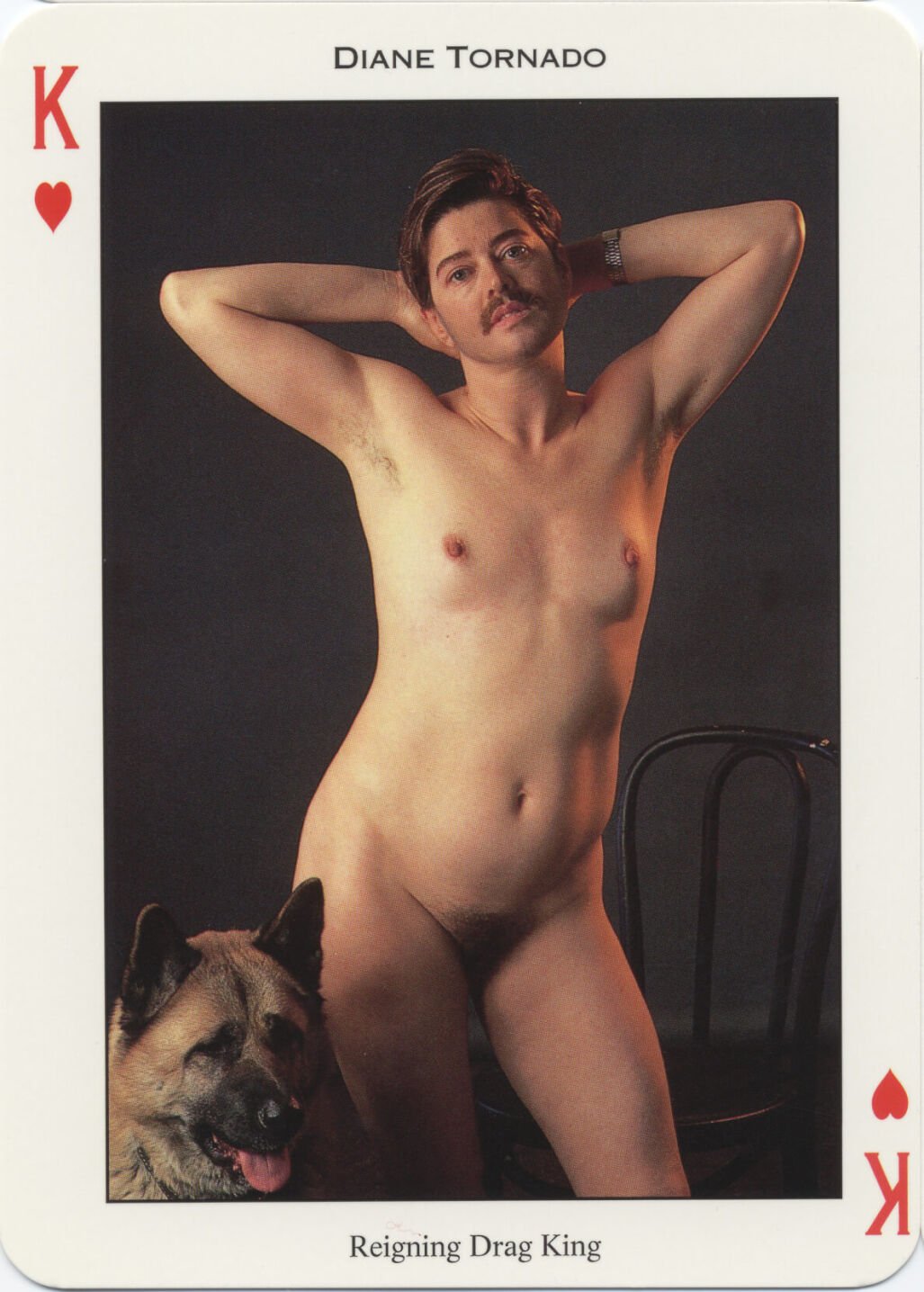
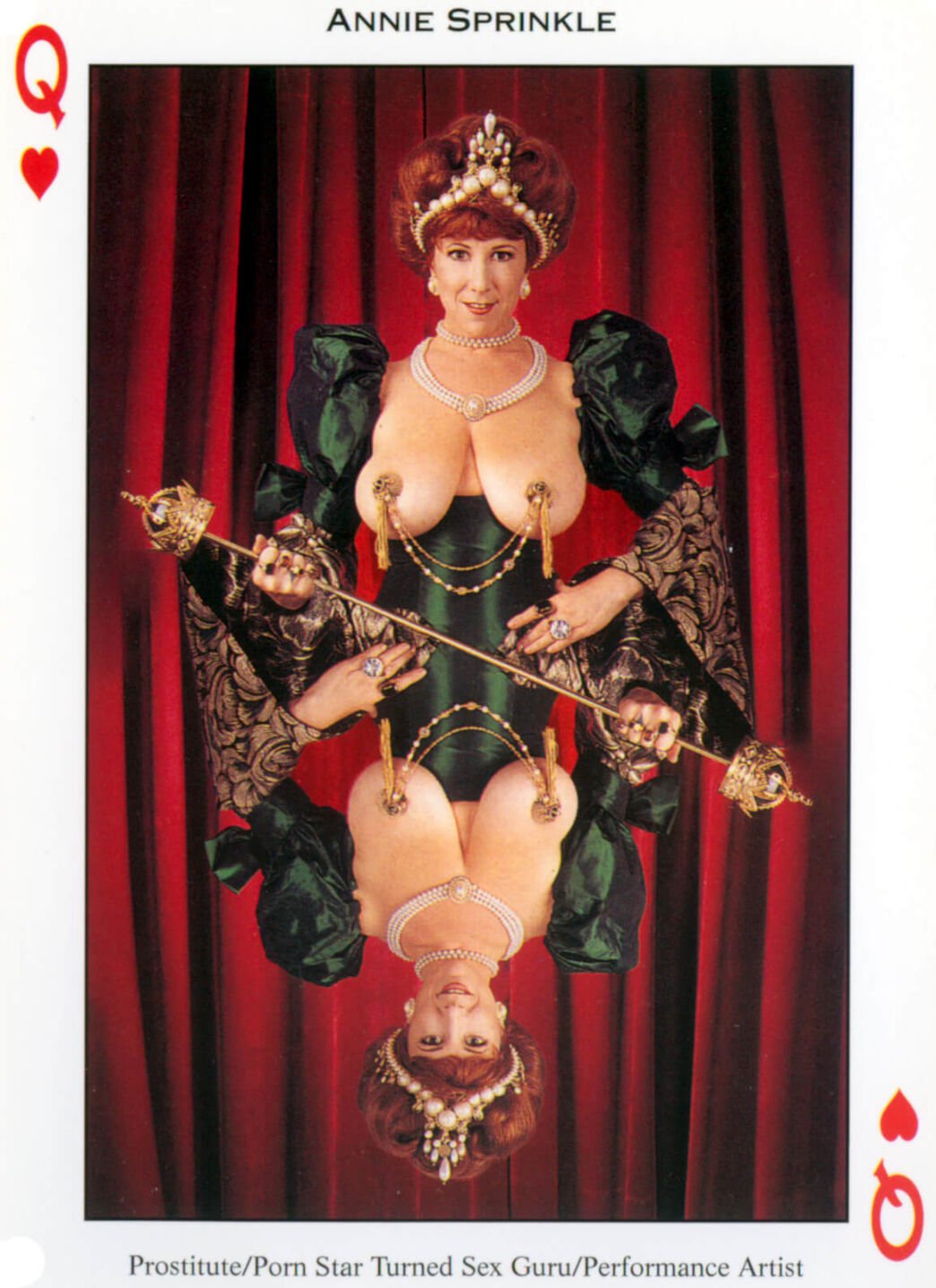
AS: I first met trans people in porn in the 1970s, and over the years I have had quite a few trans lovers. What I remember about that time in the early 90s is that all the trans guys in the support group wanted to pass as cis males. That was a big struggle back then. Of course, some trans people still want to pass. But now there’s a lot more nuance and more options and new pronouns. There’s so much more community, and more trans people who are out of the closet, and more support networks for them. The hormones can be easier to get, the surgeries have come a long way, and there is a lot more trans art and culture. Our friend and collaborator Paul B. Preciado’s book Testo Junkie is studied in colleges around the world and is a best seller. There are many more opportunities for people to be aware of trans issues, and there’s a real trans cultural flourishing – hence the violent backlash by the transphobes and haters.
Last week there was a protest here in San Francisco called Drag Up! Fight Back! in response to recent anti-drag and anti-trans legislation and attacks. It was so wonderful; it’s such a beautiful community. I was just like, “these are my people and I adore them and I feel so lucky to be part of this community.” I wish trans and nonbinary people and people between genders ruled the world. I would love to see a world where they were not only accepted, but honored and appreciated. I can’t believe trans people are being attacked like they are right now. They’re being killed in this country and all around the world. There’s so much hatred and stupidity. Someone in Beth’s family in West Virginia was trying to tell us that he has a friend who’s a school teacher and the students are putting kitty litter boxes in toilets for kids who say that their gender is cat. I was like, “I’m pretty sure that’s an urban myth,” and I went home and Googled it and, of course, it’s just anti-trans urban myth bullshit perpetuated by [right-wing Colorado congresswoman] Lauren Boebert.
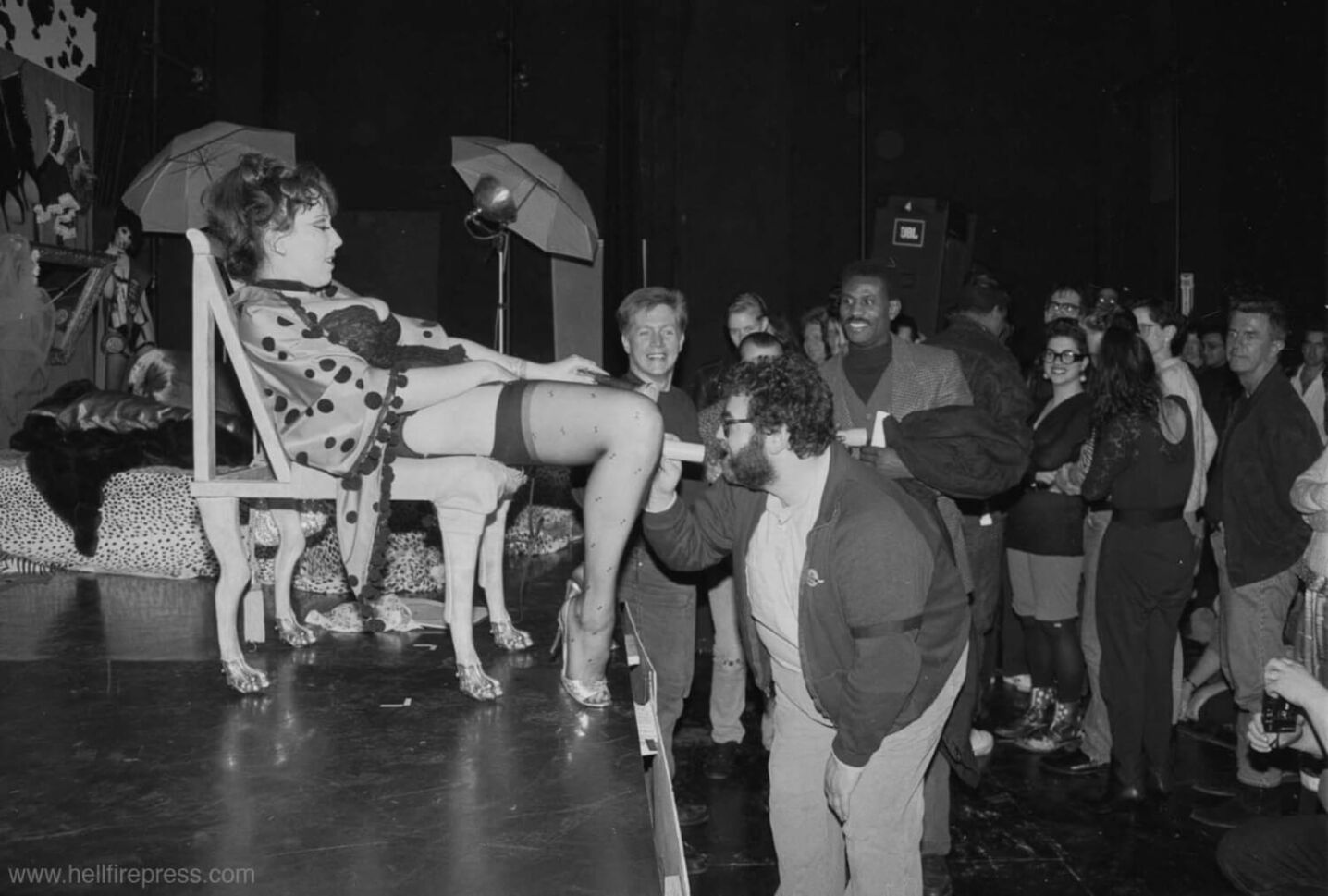
AG: That reminds me of a particular strand of reactionary hysteria before marriage equality, where it was always this concern that if you let a man marry a man, then the next day you’ll be letting a man marry a dog. Or they’d say “what’s next, WOMEN MARRYING TREES?” –
AS: – and we were here to prove them right!
AG: Haha, yes, that’s what I wanted to say – you made their worst nightmares come true.
AS: Exactly, and we’re proud of it.
AG: Some might wonder why you would bother working with the institution of marriage as part of a queer art practice, but I think that by proliferating it so much and staging it so many times through such expansive relations, you and Beth have really messed with the idea of marriage.
AS: We have done a series of weddings as performance art projects. At our first wedding ritual, our friend Barbara Carrellas did a performance called Ten Reasons Why Marriage Should Be Abolished. We loved it. So we kept having objections as a part of all our subsequent weddings. In the invitations, we tell people not to bring gifts – instead, we ask them to co-create the wedding with us. We always involve a lot of different collaborators. Also, all the wedding guests can join us in the vows to “love, honor and cherish” the mountains or the water or the rocks or the snow or whatever, and it can make them feel more connected to those entities and elements. Everyone knows the narrative parts of a wedding ritual, so everyone – artists and non-artists – can plug into the ceremony in all kinds of ways. We keep thinking we’re done with the wedding project, but we keep coming back to it. We recently married fire because we felt that we needed to deepen our relationship with it, as we have had a lot of fires and we’ve been evacuated here in Northern California. We are now making a film called Playing with Fire.
AG: And you started to identify as ecosexual after you married the Earth, is that right?
AS: When we married the Earth in 2008, it changed us forever. We woke up the next day and it just felt so right to acknowledge how much we loved the Earth. We didn’t invent the word ecosexual; it was around a bit as a dating term. But we ran with it, added to the definitions, and launched an Ecosex Manifesto, which made ecosex
into a movement. For us it’s an art movement, and it has really caught on. People like how inclusive it is. Beth and I want to make the environmental movement a little more sexy, fun and diverse. It’s an affinity group where we can be fun and wild and free and dress up in drag, and at the same time be serious about the environmental issues facing us all. For me, it’s also a sex education project and a way for people to expand on society’s limited concept of what sex is, where it’s only thought about as bodies and genitals coming together. If you’ve ever had body-to-body sex outside in nature, it can be the best sex you’ve ever had, because it’s bigger than you and your partner. It’s sex with the environment too, and a whole very sensual ecosystem.
AG: I also wanted to ask you about ecosexuality and trans identity. You and Beth cast your friend Sandy Stone [trans theorist and performance artist] to be the voice of Earth in your film Water Makes Us Wet, and you’ve often said that the Earth is trans. What do you mean? And what happens to gender when we expand our sensual relations and embrace the Earth as a lover?
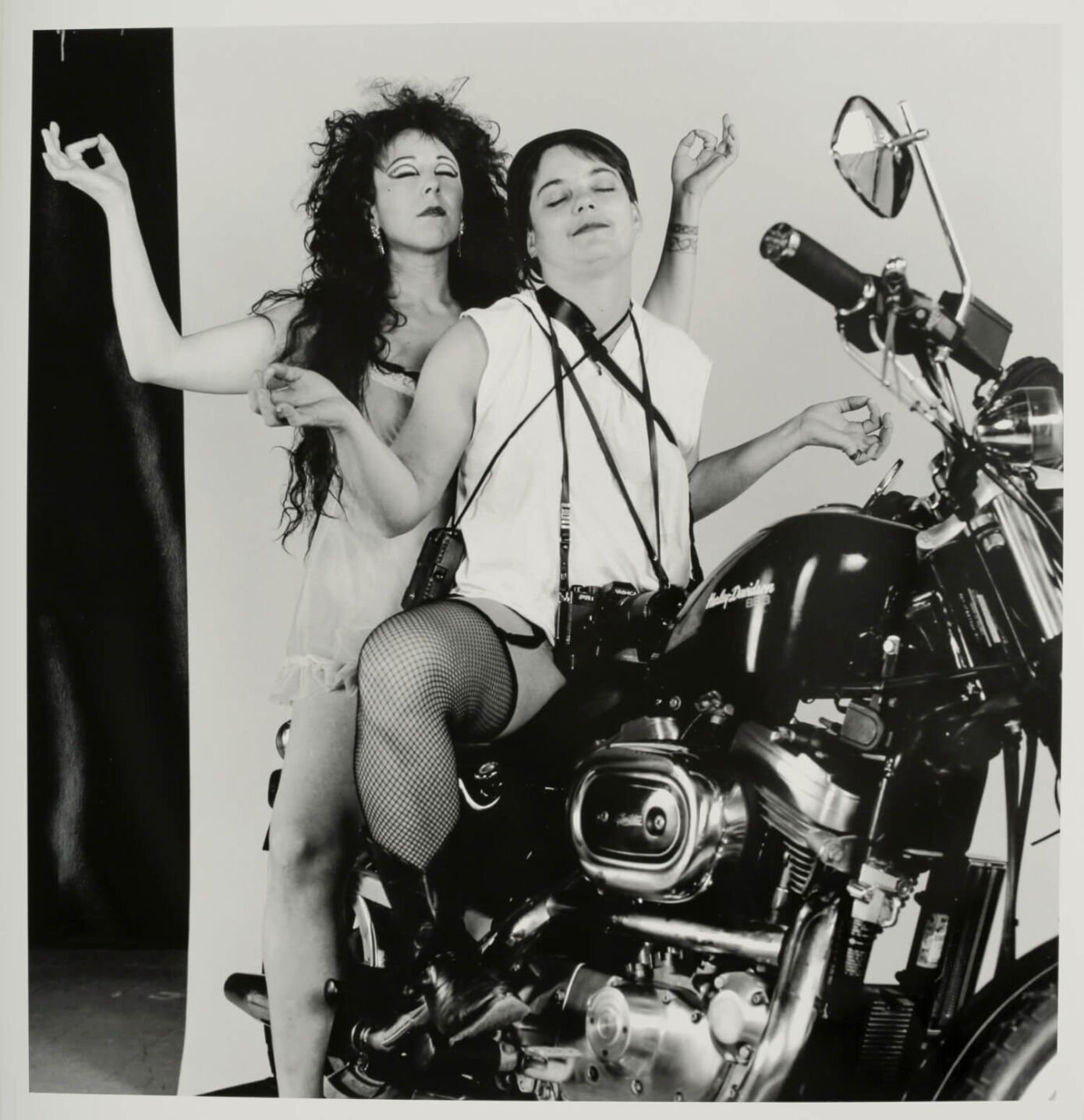
AS: I just tweeted a definition of ecosexuality; we have a lot of different definitions — let me find it, here it is: “Ecosexuality: An expanded form of sexuality that imagines sex as an ecology that extends beyond the physical body.” And that involves acknowledging that things are interconnected. In our text 25 Ways to Make Love to the Earth, we use she, he, and they pronouns and we mix them up. We imagine the Earth as trans, multi-gendered, and fluidly gendered. I mean, it seems so obvious. As humans, we’re only a little part human. We’re water and stardust and microorganisms and minerals and fungus, and we’re also not so different from other animals, DNA-wise. We are the Earth. And the Earth is straight and gay and queer and trans and genderqueer and genderfluid and it’s everywhere and sex is happening everywhere in billions of ways and it’s natural. This thing we got into that says you have to be a man or a woman and stay that way – it’s so limiting and narrow. I mean, it actually hurts to think that there are people who wanna make humans fit only into male or female and just eradicate everything else. Excruciating! It’s absolutely impossible.
AG: “Earth as lover” is an alternative to the older idea of “Earth as mother,” right?
AS: Yes. Of course, we are anthropomorphizing, because it helps us get closer to nature, but really the Earth is beyond gender completely. It’s all fantasy and imagination. People imagine god as a white male with a long beard to try to access god, who is probably not a white male with a long beard. We can imagine the Earth in all kinds of ways; father, sister, friend, MILF, host…like many people and cultures, Beth and I do imagine the Earth as a mother sometimes. A mother in menopause.
AG: We spoke earlier about the Sprinkle Salon that you had in your apartment in New York in the ‘80s and ‘90s. Something else that came out of that space was Club 90, a female porn star support group, which was the first of its kind. It was called Club 90 after the location of your apartment, 90 Lexington Ave, is that right?
AS: Yes. I just watched a TV talk show that was recently digitized, the Club 90 support group women appearing on the Richard Bey talk show in 1988. The idea of feminist porn was just becoming a thing, and we were trying to promote sex-positive feminism. It was amazing to watch. I was blown away by how eloquent my dear friends were, and I remembered how terrified I was to speak that day. At one point, I told everyone that I’d had sex with 2000 men, and I remember my friend Candida [Royalle] was so mad at me for that. She was trying to fight for acceptance and I was so over the top; she was trying to put our best foot forward and promote her films for women and couples in suburbia, and I wanted to be experimental and see what happens if you tell the world you love to fuck and you’ve literally fucked thousands of guys. I realize now that we had slightly different agendas. I wanted to be a conceptual artist. The creative impulse has always been my guide — my clit and my creative impulse. Candida was an artist too, and a great one. But I was the provocateur, and she was the velvet glove.
AG: Is that video available online somewhere?
AS: Yes, through Candida’s archives at Harvard’s Radcliffe Institute. I’ve become an archivesexual lately; I get off placing archives! I’m working with my old friend [the sex worker and author] Dolores French to find a place for her archives. Much of Johnny Science’s archives ended up in a dumpster when he died. Luckily Diane [Torr] and Kit [Rachlin] went and salvaged a bunch of it, and now it’s at NYU. That happens so often to people who lived on the so-called fringe; the partners or the family are embarrassed about who they were and they want to erase that and then the history isn’t there for future generations. So I’m trying to help preserve our herstories. Right now, I’m trying to help find good homes for the archives of four friends, including my long-time friend Spider Webb, the tattoo artist.
AG: Back in 1991, when this issue of MRPJ was published, AIDS was raging. How did the crisis affect your work and change your life?
AS: AIDS was devastating! The Great Dying! I was a working prostitute and pornographer during those years. I was in Manhattan, and I was part of the New York Healing Circle. I went to ACT UP a bit, but I was mostly involved with the Healing Circle. We were the lovers more than the fighters. We needed it all! AIDS taught me a lot about life, death, love, and community, and it made me get in touch with my feelings. I was more cut off before, but through AIDS, I was able to really cry.
AG: I wanted to ask you about activism and pleasure. When AIDS hit, you were quick to respond with your safer sex workshops and other educational initiatives that maintained an emphasis on sexual possibility and enjoyment. In the 80s, you protested against anti-porn feminists, while insisting on feminist sex positivity. Pleasure has always been in the foreground of your politics. Now that you are more involved with ecological frameworks, can you comment on the role of pleasure in environmental activism?
AS: Well, pleasure makes life worth living. I heard someone say the other day that the term “pleasure activist” was coined in 2019, but it was around in the 1990s. Maybe even the 80s. I published my Pleasure Activist Playing Cards in 1995. But anyway, we live in a sex-negative society, where sex is sinful and dirty and shameful. And it’s also a pleasure-negative society; suffering is definitely more socially acceptable than pleasure. Sometimes it takes conscious effort to stay sexually active, and sometimes you have to put in effort to experience sensual pleasures – to really enjoy delicious food, to love the smell of a honeysuckle flower, to marvel at a sunset, to enjoy watching bees pollinate, to take pleasure in all the many shades of green in a forest... Beth and I produce public performances. One is called Free Sidewalk Ecosex Clinic, where we have a team of clinicians write psychomagic prescriptions for people to do nurturing activities outside, to try to remind them that there is a lot of pleasure and nourishment out there to be had. A prescription might say something like “lie down on some nice grass and hug the Earth and sniff the soil for fifteen minutes on a Tuesday at noon.”
AG: What else has changed since 1991?
AS: So much. One thing that comes to mind is strap-on dildos. I made porn with strap- ons way back in the 70s, but it was a hard plastic cock with a thin piece of elastic with snaps that would go around your hips. It was terrible. You would have to hold it at the base, and it didn’t work very well at all. But now dildos and strap-ons are so sophisticated: the shapes, colors, materials, the toxicity — it’s all vastly improved. The sex toy industry has been making more products that are environmentally friendlier. Of course, for ecosexuals, you can simply use organic vegetables.
AG: Well, that’s an ancient technology!
AS: Yes, true.
AG: There’s a part of your website where you describe your sexual journey as going “from Het, to Bi, to Lesbian, to Ecosexual.” I wanted to ask you about this evolution. How have you experienced the changes over time?
AS: Some people find themselves, and find what they want, and stick to it. And some of us are metamorphosexuals – that’s a word I made up – which means we change at different points in our lives. I think most people go through changes and phases over their lifetimes, and their sex lives reflect those changes. Especially people in queer and trans communities. Things change over the years: our partners change, our sexual identities can change, our desires, our levels of sex drive, and so on. I’m 69 now, and I’ve been doing work about sex and documenting my sex life for more than half a century. My body has been a laboratory for my sex research. Amazingly, there’s still so much to learn. Sex and gender are endlessly fascinating to me. As is love.
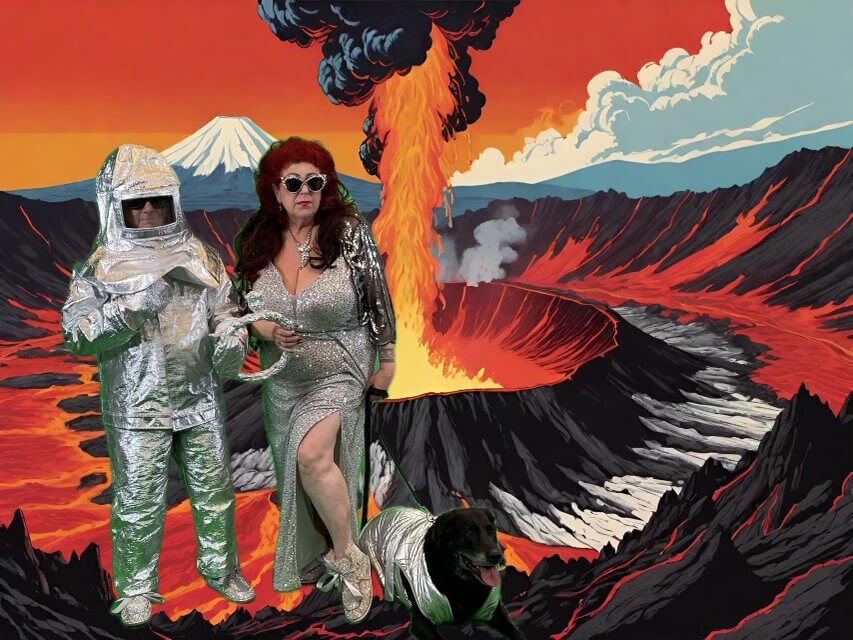
AG: Can you offer any sex advice for people in their 60s and 70s and beyond?
AS: Well, the only answer that always answers questions about sex is: it depends. It’s so individual; every person is an entire erotic universe unto themselves. I would ask about an individual’s sexual history, their fantasies, have they had cancer treatments, surgeries, traumas, lack of experience, do they want genital sex, do they want affection, are they turned on by porn, what do they like, dislike, is their desire low or high, have they been there, done it, and are over it, or are they a 70-year-old virgin? That’s what I love about ecosex. Everyone loves the sensuality of nature; it’s a common denominator. My best advice is to read our book, ASSUMING THE ECOSEXUAL POSITION; the Earth as Lover. LOL.
AG: I spent some time with your early work while preparing for this interview, and I noticed that the ecosex stuff was actually always there, long before it was named as such. You contributed to the 1991 anthology Bi Any Other Name: Bisexual People Speak Out with an essay called “Beyond Bi,” in which you declared “I literally make love with things like waterfalls, winds, rivers, trees, plants, mud..." I also found “Annie Sprinkle’s Guidelines for Sex in the 90s,” in the 1991 Angry Women issue of RE/Search, where you wrote, “Our Earth and sky are painfully polluted. Make love to them, and they'll make love to you. Send them your sexual energy. They love it.”
AS: Well, yes, the pleasures of the nonhuman realms have always been a part of my erotic awareness. But then again, humans are part of the Earth. All human sex is ecosex too.
AG: Annie, you’ve lived an amazing life and you’ve been so prolific and generous with your sluttiness.
AS: I’ve had a good life. I’ve been so lucky and very privileged. If I died tomorrow, I would die happy. I wish I could stop the wars; I would give my life to stop any war. The human world is really tragic right now, and it doesn't seem to be getting better. I still believe that peace is possible. I don’t understand why there aren’t more benevolent leaders who promote peace, love, compassion…. War is, of course, the worst perpetrator of environmental destruction. It doesn’t only kill people, it also kills all the creatures in the soil, the fish, the birds, horses, and it pollutes the air, and water, and everything.
Our films are a drop in the bucket, but maybe getting a few people to love the Earth could have some kind of ripple effect. Just last month, local government officials finally ordered Nestlé to stop taking water from the San Bernardino National Forest here in California. Nestlé had unlimited access to the natural springs, and they were paying scientists very well to say that everything was fine; but there were biologists, like the one in our film [Water Makes Us Wet], who were saying, “no, this is ecologically destructive and not right.” Several species had no water and were becoming extinct. So I like to think that our film was a little part of that success. We helped save some little birds, fish and snakes. The work that Beth and I and our collaborators do is not everybody’s cup of tea, but it resonates with some people.
And we need lots of different strategies at once. You gotta keep fighting for freedom and practicing it, because sadly, freedom can be taken away. We all have to remember that freedom isn’t free.
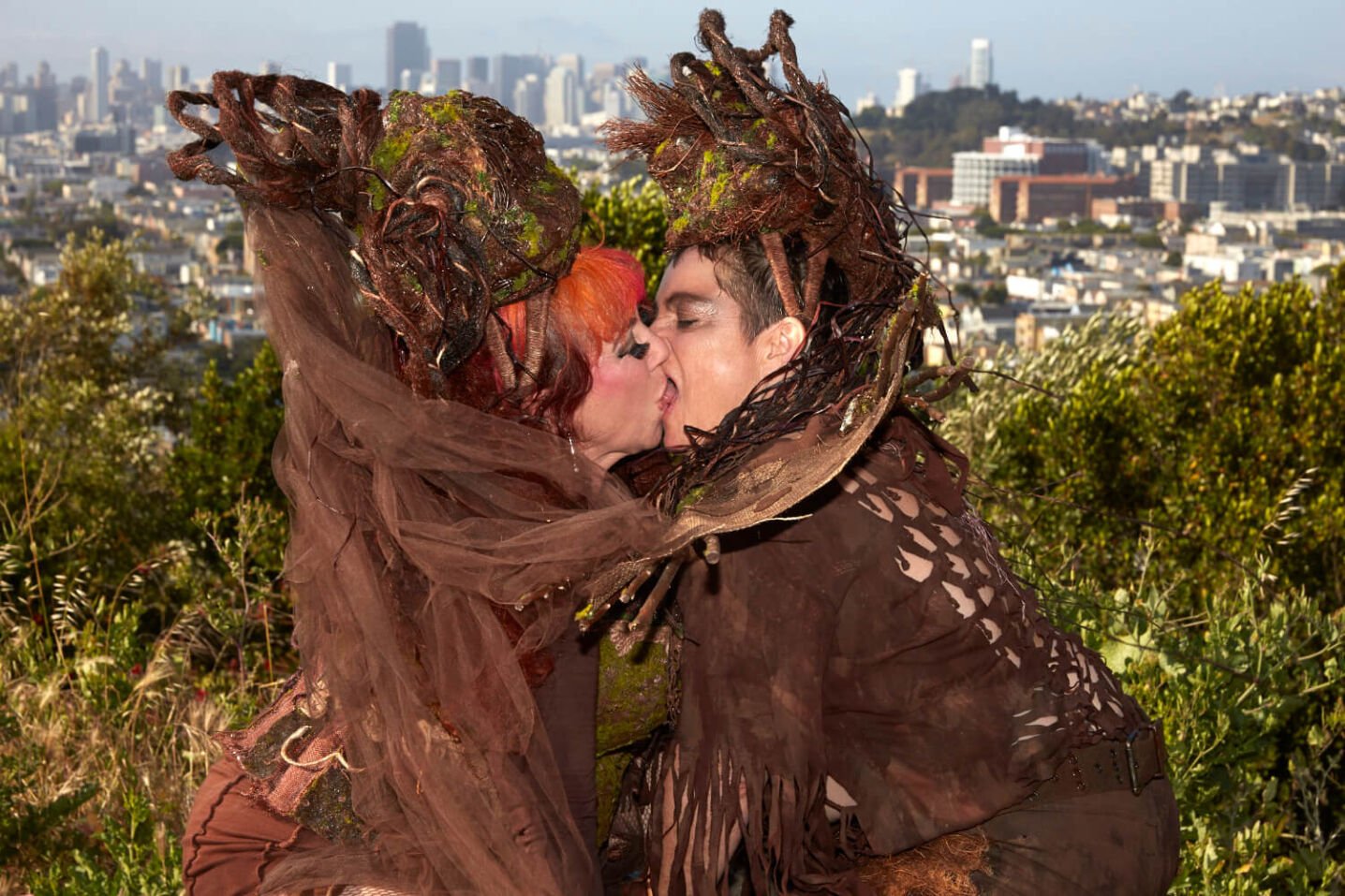
Footnotes
- For more about Annie and Beth’s work, visit sprinklestephens.org. Their book ASSUMING THE ECOSEXUAL POSITION — THE EARTH AS LOVER is published by University of Minnesota Press.
Keep Reading
DJing as a Mediumship Practice
I was a dancer before I was a DJ. And I was a medium before I was a dancer. Increasingly over the last years, and almost certainly accelerated by the...
D.O.U.B.T. - A Density
I wrote this text right before the election runoff between Donald Trump and Joe Biden, in November 2020. It marked a departure from addressing white patriarchy directly in my own...
Anh interviews Ann and Avgi
Anh Vo: Gender Without Identity is an amazing and dangerous book. As rich as it is, the relationship between gender, especially its minoritarian forms, and trauma can be easily weaponized....
Centerfold
Issue #3 of the Movement Research Performance Journal was published the year after Judith Butler’s Gender Trouble, though both grew out of a burgeoning scene of queer performance practices in...